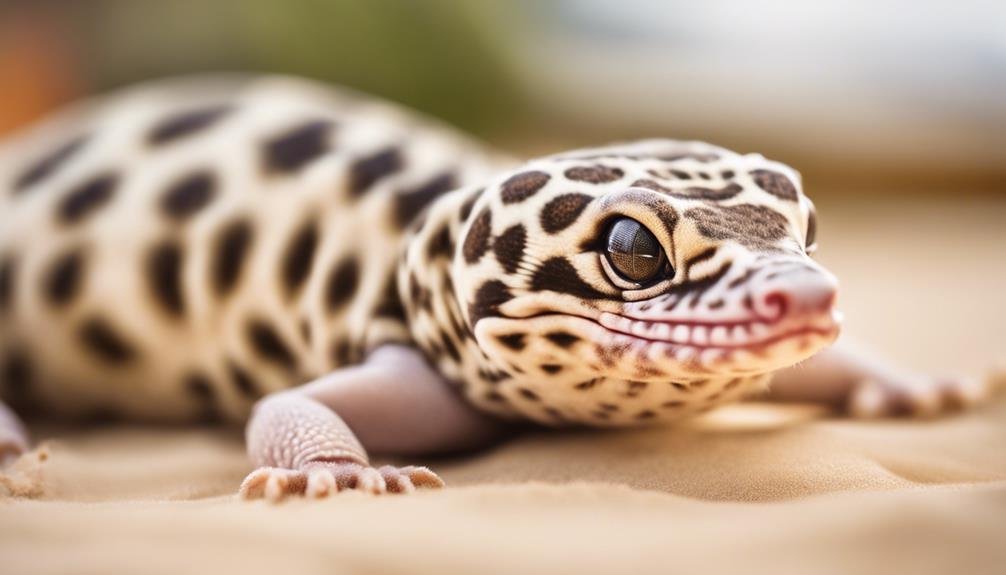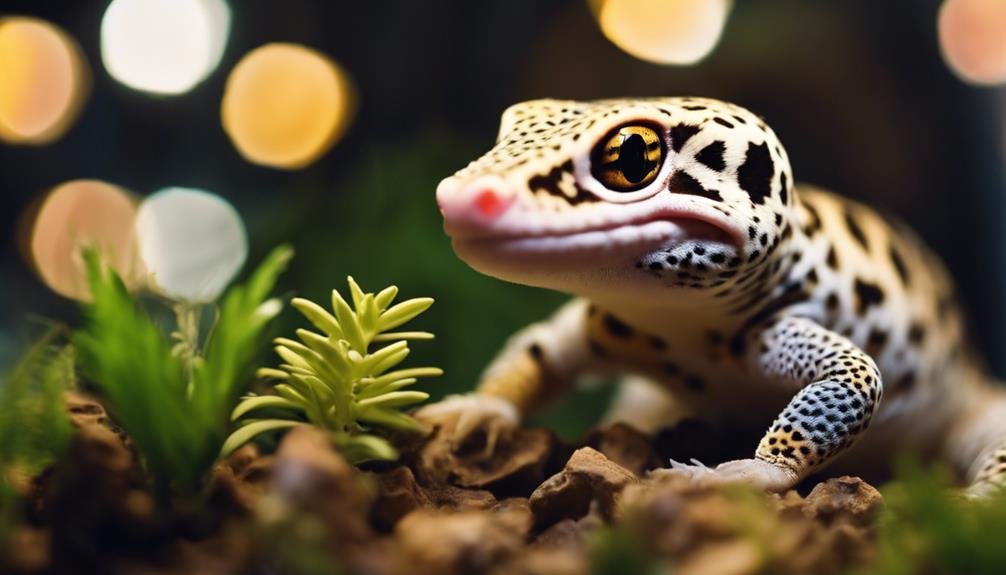You might be aware that your leopard gecko’s sporadic, dizzying spins aren’t just quirky behavior but could be symptoms of the Enigma Syndrome, a condition marked by serious neurological issues, including disturbing death roll seizures. As a responsible pet owner, it’s vital to understand the genetic roots of this syndrome and the role environmental stressors play in triggering these symptoms. While there’s no cure yet, strategic breeding and specific care strategies can greatly manage and possibly reduce the occurrence of these seizures. Let’s explore how slight changes in your gecko’s environment and diet could substantially affect their wellbeing.
Key well-being, “death roll,” is a symptom of Enigma Syndrome, which indicates severe neurological distress in leopard geckos.
- Enigma Syndrome is inherited genetically, affecting leopard geckos’ coordination and behavior.
- Symptoms of the syndrome, including seizures, can be exacerbated by environmental stressors.
- Managing habitat conditions and diet can help reduce seizure occurrences in affected geckos.
- Consultation with a reptile-savvy veterinarian is crucial for diagnosing and managing Enigma Syndrome in leopard geckos.
Understanding Enigma Syndrome


Enigma Syndrome is a neurological disorder that affects leopard geckos, causing unpredictable and often severe behaviors such as the death roll. You may not know this, but it’s tied deeply to genetic inheritance. This means that the disorder can be passed from parent geckos to their offspring, often without the breeder realizing until the symptoms manifest in younger geckos.
As a leopard gecko enthusiast, you must understand breeders’ responsibility in managing this condition. By identifying and tracking the lineage of their breeding geckos, responsible breeders can mitigate the spread of Enigma Syndrome. They must avoid breeding individuals who are known carriers of the genes responsible for this disorder. This isn’t just about preventing financial losses, maintaining a good reputation, and ensuring well-being.
When choosing a well-being, always inquire about its genetic history. Reputable breeders will be transparent about any occurrences of Enigma Syndrome in their lineage and will have taken steps to reduce its propagation. Remember, your awareness and choices can help control the prevalence of this challenging condition in captive-bred leopard geckos.
Symptoms and Diagnosis
Now that you know Enigma Syndrome’s genetic aspects, let’s examine how to recognize its symptoms and diagnose leopard geckos. Identifying symptoms early can help manage your gecko’s condition effectively.
Behavioral triggers, often linked to genetic predisposition, play a significant role. You’ll notice unusual behaviors that might indicate the presence of Enigma Syndrome. For a detailed understanding, here’s a straightforward table that outlines common symptoms and corresponding diagnostic steps:
| Symptom | Diagnostic Step |
|---|---|
| Circling or spinning | Observe frequency and triggers in habitat |
| Death rolling | Document episodes, note duration |
| Star gazing | Check for consistent patterns daily |
| Uncoordinated movements | Video record to show vet |
| Severe disorientation | Neurological exam by reptile specialist |
Each symptom requires careful observation. Recording these behaviors can provide valuable insights to a vet specializing in reptiles, who might use neurological exams or behavior assessments to diagnose the syndrome. It’s important to differentiate these signs from normal quirks or other health issues. Always consult a professional to ensure you interpret the signs correctly and provide the best care for your gecko.
Causes of Death Roll Seizures


Although several factors can trigger death roll seizures in leopard geckos, genetic predisposition is often a primary cause. You might notice that these seizures don’t just appear out of the blue. They’re frequently linked to specific genetic lines, suggesting heredity plays an important role. Knowing their genetic history is important to avoid propagating this distressing condition if you’re considering breeding your geckos.
Besides genetics, environmental stressors greatly impact your gecko’s health. Changes in their habitat, such as fluctuating temperatures, inadequate humidity, and improper lighting, can stress your gecko and potentially trigger a seizure. It is crucial to maintain a stable and suitable environment that mimics their natural habitat as closely as possible. Stress can also arise from overcrowded living conditions or insufficient hiding spots, essential for your gecko’s sense of security.
You’ll need to minimize these stressors to keep your leopard gecko healthy. Please pay close attention to their living conditions and any signs of distress. Remember, a happy gecko is healthy, and understanding the causes of death roll seizures can help you provide the best care possible for your pet.
Treatment Options
If your leopard gecko experiences a death roll seizure, several treatment options can help manage and possibly reduce future occurrences. First, you’ll want to contemplate dietary adjustments. Ensuring your gecko has a balanced diet enriched with essential nutrients can make a significant difference. Incorporate calcium and vitamin D supplements to support neurological health. These adjustments can stabilize their overall condition and might reduce the frequency of seizures.
Temperature regulation is another critical area to focus on. Leopard geckos require a specific range of temperatures within their habitat to thrive. With careful monitoring, you should maintain a gradient from about 75°F on the cool side to 90°F on the warm side to avoid any drastic fluctuations that can stress your gecko. Installing a reliable digital thermometer can help you keep things consistent.
Additionally, consult a reptile-savvy veterinarian who can prescribe medication if the seizures are severe or frequent. Anticonvulsant drugs, while not commonly used, might be considered in extreme cases. Remember, each gecko is unique, and what works for one mightn’t work for another. Regular check-ups can keep you on top of your pet’s health, adapting the treatment plan.
Managing Enigma Syndrome


How can you effectively manage Enigma Syndrome in your leopard gecko? First, it’s vital to understand that this condition has a genetic predisposition, meaning it’s inherited. Knowing the genetic history of your pet can help anticipate potential issues.
Creating a low-stress environment to manage your gecko’s condition would be best. This includes setting up a well-structured habitat with minimal noise and disturbances. Keep handling to a minimum, as stress can trigger seizures in geckos with Enigma Syndrome.
Feeding your gecko also requires careful attention. Ensure their nutritious diet is easy to digest to avoid additional health complications. Regular, gentle interactions can help reduce stress and monitor their health closely.
Regarding breeding ethics, it’s important to consider the implications of passing on genetic disorders. Ethical breeding involves selecting against traits that lead to such conditions. It would be best if you discussed with breeders and experts the morality and long-term impacts of breeding leopard geckos known to carry Enigma Syndrome genes. This careful consideration helps prevent the propagation of the syndrome in future generations, aligning with responsible pet ownership and conservation principles.
Research and Future Prospects
Research into Enigma Syndrome in leopard geckos is advancing, with promising prospects for genetic understanding and treatment options. Scientists are diving deep into genetic mapping to pinpoint the mutations responsible for this debilitating condition. You’ll find it fascinating how this approach seeks to comprehend the syndrome and safeguard against it. By identifying the specific genetic markers, researchers can develop targeted therapies that might one day mitigate or even eliminate the symptoms associated with Enigma Syndrome.
As part of this effort, breeding recommendations are being refined. If you’re a breeder, you’ll be guided on how to avoid propagating the traits that lead to this syndrome. This is essential for the health of the geckos and the ethical considerations of breeding practices. The aim is to secure a healthier future generation of leopard geckos.
The ongoing research promises to bring more sophisticated diagnostic tools and effective management strategies. You’ll likely see a shift in handling this condition, moving from merely symptomatic treatment to a more preventive and strategic approach. This could revolutionize care for Enigma Syndrome, turning what was once a perplexing issue into a manageable one.
Conclusion
You’ve learned about Leopard Gecko Enigma Syndrome and its effects on your pet’s health. By recognizing symptoms like seizures and death rolling, you can seek timely help.
Remember, managing stressors and maintaining proper care to mitigate these symptoms is important. Stay informed and consult with a vet to navigate treatment options effectively.
Your proactive steps are essential in enhancing the wellbeing of yowellbeingnd and potentially shaping future research in this area.


